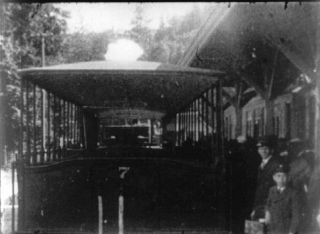Ken Jacobs’ Nervous System: 5
Date: 9 November 2000 | Season: Ken Jacobs Nervous System
KEN JACOBS’ NERVOUS SYSTEM
Manchester Cornerhouse
Thursday 9 November 2000, at 7:30pm
ONTIC ANTICS STARRING LAUREL AND HARDY
Ken Jacobs, USA, 1998, Nervous System, b/w, sound, c.60 min
“With his Nervous System film performances, Jacobs wrings changes out of startled frames and makes the infinitesimal matter. Ontic Antics with Laurel and Hardy – the simple shift of a vowel or the advance of a film frame creates a world of definition and character. Basking in that shade of difference he plumbs the frame with surgical decisiveness and amatory delicacy. Welcome to microtonal cinema. Taking Laurel and Hardy’s Berth Marks as point of departure, Jacobs supersedes slapstick, moving into the deeper dimensions of the human comedy. Psychological imbroglios, time-space predicaments, the unruliness of uncooperative gravity, the unlimited expressiveness of the limited body hallucinated into Rorschach-ing deliveries.” (Mark McElhatten)
Hardy walked a thin line between playing heavy and playing fatty. Laurel adopted a retarded squint, with suggestions of idiot savant. Their characters were at sea, clinging to each other as industrial capitalism was breaking up and sinking. Beautiful losers, they kept it funny, buoying our spirits. Laurel and Hardy … forever. (Ken Jacobs)
BERTH MARKS
Lewis R. Foster, USA, 1929, 16mm, b/w, sound, 18 min
Oliver Hardy goes to meet his partner Stan Laurel at the train station. They have a vaudeville act, which involves a bass fiddle, and are on their way to their next performance. They just barely make the train and are led to their berth, wreaking havoc amongst the other passengers in their wake. With much difficulty, they undress in their berth. As soon as they’re ready for bed, they arrive at Pottsville, their destination, and have to hurry off. Once the train has left the station, they discover that they have left their bass fiddle on board. But the situations aren’t important, it’s what the boys do with them – the way Ollie wanders around the station in search of Stan, just missing him several times, and the various contortions the pair try to get into their upper berth – that give the film its fun. Especially nice is the interchange between the boys and the conductor. When Ollie describes himself and Stan to the trainman as a “big-time vaudeville act”, the old man dryly replies, “Well, I bet you’re good !” (Janiss Garza, All Movie Guide)
DISORIENT EXPRESS
Ken Jacobs, USA, 1996, 35mm, b/w, silent, 30 min
1906 – Original cinematographer unknown. 1996 – New arrangement by Ken Jacobs. Shots shown as found in “A Trip Down Mount Tamalpais”, the Paper Print Collection, Library of Congress. Optically copied by Sam Bush, Western Cine Lab., Denver, from l6mm to 35mm letterbox format to allow double-image mirroring in 1:85 ratio projection.
The same string of shots, in their entirety, is repeated in various placement and directional permutations. But this film is not a lately arrived example of ‘‘Structural Cinema”, where methods of ordering film materials often came to take on paramount value. (The viewer at some point grasped the method and that could be pretty much it.) I’m for order only to the extent it provides possibilities of fresh experience. For instance, kaleidoscopic symmetry in Disorient Express is not an end in itself. The radiant patterning that affirms the screen plane serves also to provide visual events of an entirely other magnitude. Flat transmutes repeatedly to massive depth illusion; yet that which appears so forcefully, convincingly in depth is patently unreal – an irrational space. The obvious filmic flips and turns (method is always evident) of the scenic trip provide perceptual challenges to our understanding of reality, and we are often unable to see things as we know they are.
With light-source shifted from heaven-sent to infernal, we see a landscape that could never be, except via cinema. A very early recording of a train trip through mountainous terrain, enthusiasm of the adventurous passengers on boisterous display, lends itself to us for a ride into each our own Rorschach wilderness. This careening trip also demands some hanging on, some output of viewer energy. The rightness of the closure (as I see it) was made possible by copying the film, for the last pass, in reverse motion.
Disorient Express takes you someplace else. A spin lasting 30 minutes, you really need to tap into your own reserves of energy. Hang on, please, this is not formalist cinema; order interests me only to the extent that it can provide experience. Watch the flat screen give way to some kind of 3D thrust, look for impossible depth inversions, for jewelled splendour, for CATscans of the brain. I’m banking on this film reviving a yen for expanded consciousness. (Ken Jacobs)
